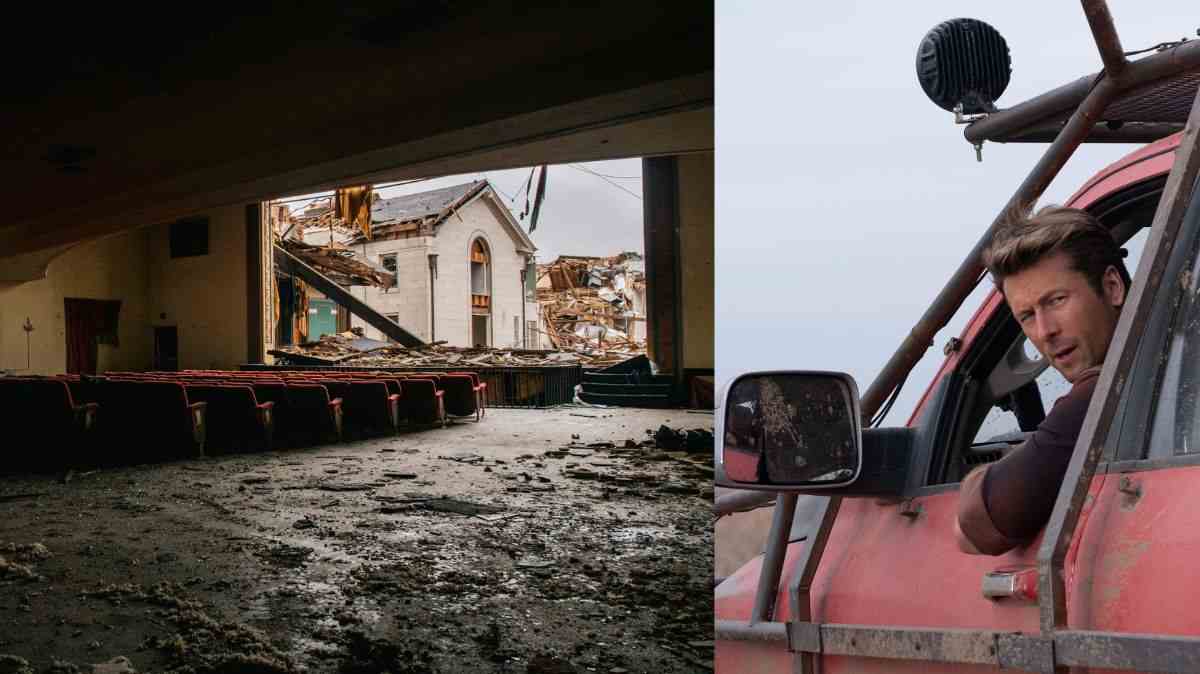In the realm of cinematic achievements, few genres capture the raw power of nature as effectively as disaster films. “Twisters,” directed by Lee Isaac Chung, stands out not only for its thrilling depiction of tornadoes but also for the deep-seated inspiration drawn from real-life events and images. The film’s visual effects supervisor, Ben Snow, meticulously crafted six major tornadoes for the movie, each based on actual tornado occurrences. The climactic tornado in “Twisters,” which anchors the third act, is inspired by three real tornadoes, including the devastating 2021 twister in Mayfield, Kentucky, which claimed 76 lives.
A pivotal image from Mayfield, Kentucky, profoundly influenced Chung’s vision for “Twisters.” The photo, taken from inside a movie theater, showcases a movie screen-sized hole created by the tornado’s winds, perfectly framing the destruction outside. This haunting image became a cornerstone for Chung, shaping both the visual and emotional tone of the film. Reflecting on this during the Filmmaker Toolkit podcast, Chung expressed how the photo’s impact went beyond mere inspiration.
The Image from Getty Images:

“When you see that photo, you can’t help but really be sober about what tornadoes can do,” said Chung. Chung stated that they were creating a movie about tornadoes that needed to be a wild, funny, and somewhat silly adventure. However, he also emphasized that the film was addressing a very serious issue occurring in the real world. From the early stages of production, the Mayfield photo held a prominent place on Chung’s mood board. He was acutely aware that “Twisters” might release during a severe tornado season, and he wanted the film to resonate with audiences who had experienced similar devastation. This awareness shaped the design and execution of the film’s final sequence.
Chung explained that they had given a lot of thought to it, and that was the design they aimed for in the final sequence. “It’s just a real thing that people are going through, and we wanted to treat that with respect.” Production designer Patrick Sullivan, who also worked on the original 1996 “Twister,” aimed to authentically portray the destruction, learning from past oversights. Set decorator Missy Parker enhanced this authenticity by incorporating trees wrecked by actual tornadoes into the set. Sullivan and Parker meticulously designed and dressed homes before dismantling them, ensuring the remnants of people’s lives were as evident as the physical destruction. This approach highlighted the human element within the chaos, portraying the upended lives behind the debris.
Beyond its sobering reminder of nature’s fury, the Mayfield photo resonated with Chung on multiple levels. He saw layers of metaphor and meaning within the image, describing it as a “beautiful picture [with] a lot of very metaphoric layers.” The juxtaposition of a smaller screen torn apart to reveal a much larger reality echoed Chung’s personal quest for awe-inspiring experiences that transcend the ordinary. Lee Isaac Chung shared that he personally felt the need for more opportunities in his life to observe things much larger than himself that evoke a sense of awe. He expressed his admiration for the idea of a smaller screen giving way to something much bigger, describing it as a type of revelation he continually seeks and thinks about frequently.
The photo also served as a constant reminder of the new challenges Chung faced with “Twisters.” Unlike his previous, more intimate films, such as the critically acclaimed “Minari,” Chung approached “Twisters” with a different mindset. “Minari,” a semi-autobiographical story about his immigrant parents, showcased his knack for personal, heartfelt storytelling. “Twisters,” on the other hand, required a shift towards creating a blockbuster experience. Lee Isaac Chung mentioned that while working on “Twisters,” he felt his primary objective was to attract audiences to theaters. He noted that this was a significant shift from his previous films, which focused more on the craft of storytelling and personal recollections. Chung expressed his desire to embrace the challenge of creating a summer blockbuster and encouraging people to experience it in movie theaters.
This transition from personal stories to a large-scale disaster film was symbolized in the character of Kate, played by Daisy Edgar-Jones. Chung likened Kate to a filmmaker trying to save her movie theater, mirroring his own endeavor to revitalize the cinematic experience. In essence, “Twisters” is not just a film about tornadoes; it is a cinematic journey that intertwines real-life devastation with the art of storytelling. Lee Isaac Chung’s inspiration from the Mayfield photo encapsulates the film’s duality of thrilling entertainment and poignant reflection on nature’s destructive power, making “Twisters” a compelling addition to the disaster film genre.
Trailer:












